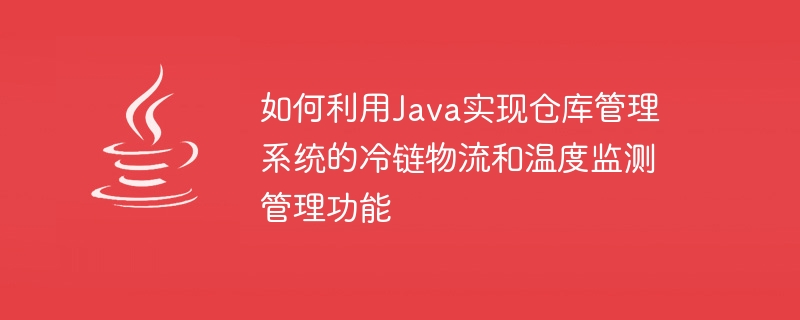

How to use Java to implement the cold chain logistics and temperature monitoring management functions of the warehouse management system, specific code examples are required
Abstract: Cold chain logistics and temperature monitoring management for warehouses Very important for management systems. This article will introduce how to use Java language to implement the cold chain logistics and temperature monitoring management functions of the warehouse management system, and provide specific code examples.
public class Goods { private String name; private double temperature; public Goods(String name, double temperature) { this.name = name; this.temperature = temperature; } public double getTemperature() { return temperature; } public void setTemperature(double temperature) { this.temperature = temperature; } } public class TemperatureSensor { public void monitorTemperature(Goods goods) { double temperature = goods.getTemperature(); // 检测温度并进行报警处理 if (temperature < 0 || temperature > 10) { // 温度异常,触发报警 System.out.println("温度异常:" + temperature); // 触发报警处理逻辑 // ... } } } public class Warehouse { private List goodsList; private TemperatureSensor temperatureSensor; public Warehouse() { goodsList = new ArrayList<>(); temperatureSensor = new TemperatureSensor(); } public void addGoods(Goods goods) { goodsList.add(goods); // 监测货物的温度 temperatureSensor.monitorTemperature(goods); } }
Through the above code example, we can see that a Goods class is first defined to represent the name and temperature information of the goods. Then, a TemperatureSensor class is defined to monitor the temperature of the goods and handle alarms when abnormalities occur. Finally, a Warehouse class is defined to manage the goods in the warehouse and call the temperature monitoring function when adding goods.
public class TemperatureMonitor { private TemperatureSensor temperatureSensor; private List temperatureList; public TemperatureMonitor() { temperatureSensor = new TemperatureSensor(); temperatureList = new ArrayList<>(); } public void collectData() { // 采集温度数据 double temperature = temperatureSensor.getTemperature(); temperatureList.add(temperature); } public void storeData() { // 将温度数据存储到数据库中 // ... } public void displayData() { // 展示温度数据 for (double temperature : temperatureList) { System.out.println("温度:" + temperature); } } }
Through the above code example, we can see that a TemperatureMonitor class is first defined to collect, store and display temperature data. In the collectData() method, use the TemperatureSensor class to get the current temperature and add it to the temperature list. In the storeData() method, store the temperature data into the database. In the displayData() method, display the temperature data in the temperature list.
Summary: This article introduces how to use Java language to implement the cold chain logistics and temperature monitoring management functions of the warehouse management system, and provides code examples. Cold chain logistics management functions include temperature monitoring and temperature alarms of goods, while temperature monitoring management functions include the collection, storage and display of temperature data. The implementation of these functions can help warehouse management systems ensure the temperature safety of goods during transportation and storage.
The above is the detailed content of How to use Java to implement the cold chain logistics and temperature monitoring management functions of the warehouse management system. For more information, please follow other related articles on the PHP Chinese website!




